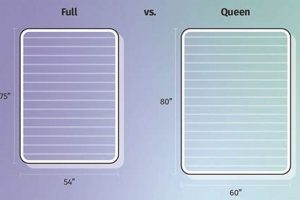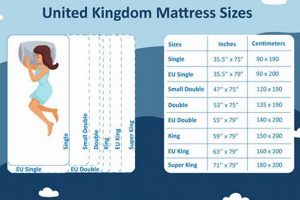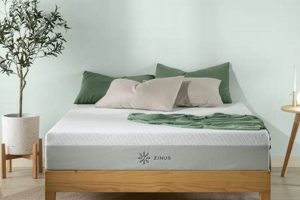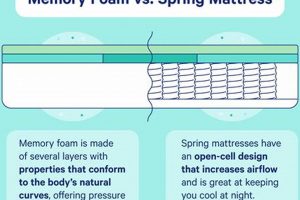The selection of a sleeping surface significantly impacts the overall experience of outdoor overnight stays. Two common options for elevated sleep systems are foldable frames with stretched fabric and inflatable pads designed for comfort and insulation. These alternatives offer distinct features catering to diverse preferences and environmental conditions.
The decision between these options is crucial for achieving restorative rest. Considerations include portability, setup ease, comfort level, insulation properties, and suitability for various terrains. Historically, frame-based systems were favored for their perceived durability and elevation, while inflatable pads gained popularity due to their compact size and customizable firmness.
The following sections will delve into a detailed comparison of the structural design, comfort attributes, thermal performance, and practical considerations associated with each type of sleep support system, enabling informed choices for subsequent outdoor adventures.
Considerations for Elevated Sleep Systems During Camping
Selecting an appropriate sleep system directly affects comfort and recuperation during camping excursions. Prioritize factors relevant to the specific environment and individual needs.
Tip 1: Assess Portability Requirements: Evaluate the packed size and weight. Frame-based options generally occupy more volume and mass than their inflatable counterparts. Consider transportation limitations and available storage space.
Tip 2: Evaluate Setup Complexity: Frame-based assemblies may require more time and effort for initial configuration compared to self-inflating or pump-assisted inflatable pads. Consider physical capabilities and setup conditions (e.g., limited daylight).
Tip 3: Examine Terrain Compatibility: Frame-based platforms are more suitable for uneven or rocky surfaces as they provide a level sleeping area. Inflatable pads require relatively flat ground free of sharp objects to prevent punctures.
Tip 4: Prioritize Insulation Needs: Inflatable pads offer superior insulation compared to frame-based systems, particularly those with integrated insulation layers or baffles. Consider the expected ambient temperature and the sleeping bag’s thermal rating.
Tip 5: Account for Comfort Preferences: Frame-based systems generally offer a firmer sleeping surface, while inflatable pads allow for adjustable firmness. Experiment with both options to determine the preferred level of support and cushioning.
Tip 6: Analyze Durability and Longevity: Frame-based structures tend to be more durable and resistant to punctures or tears than inflatable pads. However, fabric components may degrade over time. Inflatable pads require careful handling and storage to prevent damage.
Careful consideration of these factors will optimize the selection of an elevated sleep system, contributing to a more restful and enjoyable outdoor experience.
The subsequent section will address maintenance and storage strategies to prolong the lifespan of the chosen sleep system.
1. Portability (noun)
Portability, as a noun, denotes the capacity to be easily carried or moved. Its influence on the selection of camping sleep equipment is substantial. The physical attributes of both cots and air mattresses directly affect a camper’s ability to transport and manage their chosen sleep system. A cot, typically constructed with a metal or composite frame and a stretched fabric sleeping surface, generally exhibits lower portability due to its inherent weight and bulk. Conversely, an air mattress, deflated and rolled or folded, presents a significantly smaller and lighter profile. This difference in portability becomes particularly relevant for backpacking or camping scenarios involving substantial distances from a vehicle or limited carrying capacity. For example, a solo backpacker traversing a multi-day trail would likely prioritize the compact portability of an air mattress over the increased weight and volume of a cot.
The consequences of neglecting portability considerations can range from inconvenience to physical strain. Overburdening oneself with unnecessarily heavy gear can impede movement, increase fatigue, and compromise the overall camping experience. The available vehicle space also dictates equipment choices. Campers with smaller vehicles may find a cot impractical due to its storage requirements, leading to the selection of a more compact air mattress, even if other comfort factors are slightly compromised. Furthermore, the accessibility of the campsite influences the importance of portability. If the campsite is readily accessible by vehicle, the impact of weight and size diminishes, potentially making a cot a more viable option.
In summary, portability represents a key discriminator between cots and air mattresses in the context of camping. The decision hinges on balancing desired comfort levels with the practical constraints of transportation and storage. Campers must accurately assess their physical capabilities, transportation limitations, and campsite accessibility to make an informed choice that minimizes encumbrance and maximizes the enjoyment of their outdoor experience.
2. Support (noun)
The noun “support,” in the context of sleep systems, refers to the degree to which a surface maintains proper spinal alignment and reduces pressure points during rest. It is a critical factor in mitigating discomfort and promoting restorative sleep, directly impacting physical well-being during camping excursions. The relative support characteristics of cots versus air mattresses constitute a key consideration in sleep system selection.
- Spinal Alignment
Spinal alignment denotes the maintenance of the natural curvature of the spine during sleep. A supportive surface minimizes spinal stress and prevents postural distortion. Cots, typically featuring a taut fabric surface stretched across a rigid frame, generally offer firmer, more consistent support that can aid in maintaining spinal alignment, particularly for individuals who prefer or require a firmer sleeping surface. Air mattresses, conversely, may exhibit varying levels of support depending on their inflation level and internal construction. Over-inflation can result in a surface that is too firm and lacks contouring, while under-inflation may lead to excessive sagging and spinal misalignment.
- Pressure Distribution
Pressure distribution refers to the even dispersion of body weight across the sleeping surface to minimize localized pressure points. Excessive pressure on bony prominences, such as hips and shoulders, can lead to discomfort and restricted blood flow. Cots, with their relatively uniform surface tension, tend to distribute weight evenly, reducing pressure points. Air mattresses, especially those without advanced internal baffling or zoning, may exhibit uneven pressure distribution, concentrating weight in certain areas and exacerbating discomfort. The quality and type of material used also influences pressure distribution; memory foam toppers on air mattresses, for example, can significantly enhance pressure relief.
- Edge Support
Edge support pertains to the stability and resistance to compression along the perimeter of the sleeping surface. Adequate edge support is crucial for maintaining balance and preventing roll-off during sleep. Cots, due to their rigid frame construction, generally provide superior edge support compared to air mattresses. The edges of an air mattress may compress significantly under weight, potentially leading to a feeling of instability or a tendency to roll off the sleeping surface. This factor is particularly relevant for individuals who tend to sleep near the edge of the bed or who require assistance getting in and out of bed.
- Weight Capacity
Weight capacity is the maximum amount of weight a cot or air mattress can safely support without compromising its structural integrity or affecting its ability to provide adequate support. Cots typically have a higher weight capacity than air mattresses, making them suitable for heavier individuals or couples. Exceeding the weight capacity of an air mattress can cause it to sag excessively, lose its shape, or even rupture. Weight capacity specifications should always be carefully considered when selecting a sleep system, particularly for camping situations where comfort and safety are paramount.
In conclusion, the level of “support” provided by a camping sleep system is a multi-faceted consideration directly linked to spinal alignment, pressure distribution, edge support, and weight capacity. Selecting between a cot and an air mattress necessitates a careful evaluation of individual support preferences, physical requirements, and anticipated usage conditions. Failure to adequately address support needs can lead to discomfort, interrupted sleep, and potential physical strain during and after camping activities.
3. Insulation (noun)
Insulation, defined as a material’s resistance to heat flow, is a critical noun affecting the thermal comfort and safety of campers, particularly when assessing elevated sleep systems. In the context of “cot vs air mattress camping,” insulation dictates how effectively each system prevents heat loss to the surrounding environment. The earth, especially in colder climates or during shoulder seasons, acts as a significant heat sink. A lack of adequate insulation between the camper and the ground can lead to hypothermia, discomfort, and impaired sleep quality. The core principle involves minimizing conductive heat transfer; materials with low thermal conductivity impede this transfer, preserving body heat. Therefore, selecting a sleep system with appropriate insulating properties is paramount for maintaining a safe and comfortable sleeping temperature.
Cots, by their very design, often present a challenge from an insulation standpoint. The open space beneath the sleeping surface allows for convective heat loss as cold air circulates freely. Consequently, a cot alone provides minimal insulation value. To mitigate this, campers often supplement cots with insulating pads, blankets, or sleeping bags rated for lower temperatures than anticipated. Air mattresses, while seemingly offering more inherent insulation due to the trapped air, still require careful consideration. Uninsulated air mattresses can conduct heat away from the body, particularly in cold conditions. Higher-quality air mattresses often incorporate internal baffling or insulating materials to reduce heat transfer. A practical example illustrates this point: a camper using an uninsulated air mattress on frozen ground without a sleeping pad may experience significant heat loss, leading to shivering and disrupted sleep. Conversely, a camper using a cot with a closed-cell foam pad or an air mattress with integrated insulation will retain more body heat, resulting in a warmer and more restful night.
In conclusion, insulation is an indispensable element when selecting camping sleep equipment. The design characteristics of cots necessitate supplementary insulation, while air mattresses vary in their inherent insulating capabilities. Prioritizing insulation minimizes heat loss, enhances comfort, and contributes to a safer and more enjoyable camping experience. Challenges remain in accurately assessing the R-value (a measure of thermal resistance) of different sleep systems, highlighting the importance of user reviews and practical experience. The broader implication underscores the need for campers to understand the principles of heat transfer and select equipment appropriate for the anticipated environmental conditions.
4. Durability (noun)
Durability, representing the capacity of an item to withstand wear, pressure, or damage, is a critical consideration when evaluating camping sleep systems. The relative robustness of cots and air mattresses influences longevity, performance, and ultimately, the overall value proposition for outdoor enthusiasts.
- Material Resistance to Abrasion and Tearing
The materials used in constructing cots and air mattresses exhibit varying degrees of resistance to abrasion and tearing. Cot fabrics, often canvas or ripstop nylon, are generally more resistant to punctures and tears caused by rough surfaces or sharp objects compared to the thinner PVC or coated fabrics used in air mattresses. However, cot frames can be susceptible to bending or breakage under excessive weight or stress. Air mattresses, while vulnerable to punctures, can sometimes be repaired with patching kits, extending their lifespan. The selection of a campsite free of sharp debris is paramount for mitigating the risk of damage to either type of sleep system.
- Resistance to Environmental Degradation
Prolonged exposure to sunlight, moisture, and extreme temperatures can degrade the materials used in both cots and air mattresses. Ultraviolet radiation can weaken fabrics and cause PVC to become brittle and crack. Moisture can lead to mildew and corrosion, particularly affecting metal cot frames. Storing camping sleep systems in a dry, shaded location when not in use is crucial for minimizing environmental degradation and prolonging their lifespan. Regularly inspecting and cleaning the equipment also helps to identify and address potential problems before they escalate.
- Structural Integrity Under Load
The structural integrity of a cot or air mattress under load determines its ability to maintain its shape and support weight consistently over time. Cot frames constructed from high-strength steel or aluminum are generally more resistant to deformation under heavy loads compared to air mattresses, which can sag or lose firmness as air leaks occur or the material stretches. The internal construction of an air mattress, including the type of baffling and seams, significantly influences its ability to maintain its shape and distribute weight evenly. Exceeding the weight capacity of either type of sleep system can lead to premature failure.
- Repairability and Maintenance
The ease with which a cot or air mattress can be repaired and maintained affects its overall durability. Minor tears in cot fabric can often be repaired with needle and thread, while more extensive damage may require professional repair or replacement of the fabric. Air mattresses can be patched to repair punctures, but larger tears or seam failures may be difficult or impossible to repair effectively. Regular cleaning and inspection of both types of sleep systems can help identify and address potential problems early, extending their lifespan. Properly storing the equipment also contributes to its long-term durability.
In summary, the “durability” of a camping sleep system is a complex attribute encompassing resistance to physical damage, environmental degradation, and structural failure under load, further influenced by repairability. Careful consideration of these factors, coupled with proper maintenance and storage, maximizes the lifespan and value of either a cot or an air mattress. The choice ultimately depends on balancing durability concerns with other factors such as portability, comfort, and cost, specific to individual camping needs.
5. Setup (noun)
The noun “setup,” referring to the process of assembling and preparing a camping sleep system for use, significantly influences the overall camping experience. The complexity and time required for setup directly impact camper convenience and efficiency, particularly after a long day of travel or outdoor activities. The comparative ease or difficulty of “setup” is a crucial discriminator when evaluating “cot vs air mattress camping.”
- Assembly Complexity
Assembly complexity denotes the number of steps, tools, and individuals required to erect the sleep system. Cots often involve more intricate assembly procedures compared to air mattresses. Some cots necessitate connecting multiple frame components and stretching the fabric sleeping surface, potentially requiring tools or assistance. Air mattresses, on the other hand, typically inflate with an integrated or external pump, demanding minimal physical manipulation. This disparity in assembly complexity becomes particularly relevant in adverse weather conditions or when setting up camp in limited daylight.
- Inflation/Deflation Time
Inflation/deflation time represents the duration required to fully inflate or deflate the sleep system. Air mattresses generally offer a faster setup time due to electric or manual pump inflation. Inflation times can range from a few minutes for smaller mattresses to upwards of ten minutes for larger models. Deflation can be equally rapid, especially with features designed to expedite air expulsion. Cots, lacking inflatable components, bypass this step altogether. The immediacy of cot setup may be advantageous for campers prioritizing speed and simplicity. However, the lack of adjustable firmness, inherent to air mattresses, may be a trade-off.
- Portability During Setup
Portability during setup concerns the ease of moving the sleep system from its storage location to the desired sleeping area. While air mattresses are highly portable when deflated, their maneuverability decreases significantly once inflated. Similarly, cots, while relatively cumbersome in their packed state, become less portable once fully assembled. The weight and dimensions of the assembled cot may limit its placement options, particularly in smaller tents or uneven terrains. Campers must consider the accessibility of their campsite and the available space when deciding on the most suitable sleep system.
- Environmental Sensitivity During Setup
Environmental sensitivity during setup refers to the susceptibility of the sleep system to damage or malfunction due to environmental factors. Air mattresses are vulnerable to punctures from sharp objects during inflation, necessitating careful site selection and preparation. Cots, while generally more resistant to punctures, can be affected by uneven terrain, which may compromise frame stability or create uncomfortable pressure points. Campers must assess the ground conditions and take appropriate precautions to protect their chosen sleep system from environmental hazards.
In conclusion, the “setup” process represents a significant practical consideration when choosing between “cot vs air mattress camping.” The factors of assembly complexity, inflation/deflation time, portability during setup, and environmental sensitivity all contribute to the overall user experience. A thoughtful assessment of these factors, tailored to individual camping style and environmental conditions, will lead to a more convenient and enjoyable outdoor experience.
6. Space (noun)
Space, as a finite resource within the camping environment, significantly influences the choice between a cot and an air mattress. Space considerations encompass both the packed volume of the equipment during transport and the footprint it occupies within the tent or campsite. These factors directly impact comfort, organization, and overall livability during outdoor excursions.
- Packed Volume and Transportation
Packed volume, representing the dimensions of the sleep system when stored, is a primary constraint, especially for backpacking or vehicle-based camping with limited cargo capacity. Cots, characterized by their rigid frame structures, typically occupy a substantially larger packed volume compared to deflated air mattresses. This disparity can necessitate larger vehicles or the sacrifice of other essential gear. Air mattresses, compressing into relatively small packages, offer a distinct advantage in situations where space is at a premium, allowing for more efficient gear storage and transportation.
- Footprint within the Tent
The footprint, referring to the surface area occupied by the sleep system when in use, directly affects maneuverability and storage capacity within the tent. Cots, due to their elevated and rectangular design, generally consume more floor space than air mattresses. This can limit the number of occupants or restrict movement within the tent, potentially creating a cramped and uncomfortable environment. Air mattresses, conforming more closely to the tent floor, tend to maximize usable space, particularly when selecting models tailored to specific tent dimensions.
- Vertical Space Utilization
Vertical space utilization pertains to the height of the sleep system and its impact on headroom within the tent. Cots, elevating the sleeping surface significantly above the ground, may reduce available headroom, particularly in smaller tents. This can limit mobility and create a claustrophobic feeling. Air mattresses, positioned closer to the ground, preserve headroom, enhancing the sense of spaciousness and freedom of movement within the tent. This advantage is particularly noticeable in dome-style tents with sloping walls.
- Storage Capacity and Organization
The presence of a cot or air mattress influences the available storage space for personal belongings within the tent. Cots, with the open area beneath the sleeping surface, offer an opportunity for storing gear, clothing, or other items, effectively utilizing otherwise wasted space. This can contribute to a more organized and clutter-free camping environment. Air mattresses, lacking this under-bed storage capacity, may require alternative storage solutions, such as gear lofts or external storage containers, potentially increasing the overall footprint of the campsite.
In summary, space considerations represent a multifaceted aspect of “cot vs air mattress camping,” encompassing transportation volume, tent footprint, vertical space utilization, and storage implications. The optimal choice depends on balancing desired comfort levels with spatial constraints, individual camping style, and the specific characteristics of the tent and campsite. Campers must carefully assess their available space and prioritize their needs to make an informed decision that maximizes livability and enhances the overall camping experience.
7. Cost (noun)
The noun “cost,” denoting the monetary expenditure required to acquire and maintain camping sleep equipment, represents a primary determinant in the selection between cots and air mattresses. The initial purchase price, potential repair expenses, and long-term replacement costs all contribute to the overall financial burden. Understanding these cost implications allows for budget-conscious decision-making, aligning equipment choices with individual financial constraints. A direct correlation exists between features, durability, and price. More robust materials and advanced designs typically translate into higher initial costs. However, these investments may yield long-term savings by minimizing the need for frequent replacements. Conversely, lower initial expenditures may be offset by the increased probability of repairs or premature failure, resulting in a higher total cost of ownership. A practical example illustrates this principle: a camper purchasing a budget-friendly air mattress may face recurring costs associated with punctures and air leaks, while an investment in a higher-quality cot could provide years of reliable service with minimal maintenance expenses. This interplay between initial outlay and long-term maintenance defines the economic dimension of sleep system selection.
Analyzing the cost of ownership further reveals the significance of considering ancillary expenses. Inflatable systems may necessitate the purchase of pumps (manual or electric) and patching kits, adding to the initial investment. Cots, although requiring less immediate accessory purchases, may demand specialized storage solutions due to their bulkier dimensions. These implicit costs contribute to the total financial burden. Moreover, comparing the effective lifespan of each option illuminates the long-term economic implications. A durable cot, properly maintained, can withstand years of rigorous use, while an air mattress, susceptible to wear and tear, may require more frequent replacements. Evaluating these factors provides a more complete financial picture, allowing campers to make informed decisions based on both immediate and projected expenditures. Discount retailers often provide entry-level options for both cots and air mattresses; however, durability and long-term performance should be weighed against the savings.
In conclusion, “cost” functions as a central determinant in choosing between cots and air mattresses for camping. Consideration must extend beyond the initial purchase price to encompass maintenance, ancillary equipment, and projected lifespan. While budget constraints inevitably shape decisions, prioritizing long-term value and minimizing potential replacement costs contributes to financially responsible camping practices. Challenges arise in accurately predicting equipment lifespan and potential repair needs; however, thorough research and evaluation of user reviews can mitigate these uncertainties. Ultimately, aligning equipment selection with financial capabilities promotes both affordability and sustainability in outdoor pursuits.
Frequently Asked Questions
This section addresses prevalent inquiries concerning the selection and utilization of camping sleep systems, specifically comparing cots and air mattresses. The responses aim to provide clarity and facilitate informed decision-making.
Question 1: Is a cot or air mattress inherently warmer for camping in cold weather?
Neither a cot nor an air mattress inherently guarantees warmth. Cots, due to air circulation beneath the sleeping surface, often require supplementary insulation. Uninsulated air mattresses can conduct heat away from the body. The addition of insulating pads or blankets is essential for both systems in cold conditions.
Question 2: What are the key advantages of a cot over an air mattress for uneven terrain?
Cots offer a level sleeping surface on uneven ground, mitigating discomfort caused by rocks or sloping terrain. Air mattresses require a relatively flat surface to prevent punctures and ensure even weight distribution. The elevation provided by a cot can also improve drainage in wet conditions.
Question 3: How does the packed size and weight of a cot compare to that of an air mattress?
Cots generally exhibit a larger packed size and greater weight compared to air mattresses. Air mattresses, when deflated, compress into a significantly smaller volume, facilitating easier transport, particularly for backpacking. The rigid frame of a cot contributes to its bulkiness.
Question 4: What are the primary durability concerns associated with air mattresses used for camping?
Air mattresses are susceptible to punctures from sharp objects, tears from abrasion, and seam failures due to excessive weight or pressure. Selecting a durable model with reinforced materials and practicing caution in campsite selection minimizes these risks. Patching kits offer a temporary solution for minor damage.
Question 5: Does the setup time differ significantly between cots and air mattresses?
Setup time varies depending on the specific model. Some cots require intricate assembly, involving multiple frame components. Air mattresses, typically inflated with a pump, generally offer a faster setup. However, manual inflation can be labor-intensive. Deflation can also be a time-consuming process for some air mattresses.
Question 6: How does the cost of a cot compare to the cost of an air mattress of comparable quality?
Cots often represent a higher initial investment compared to air mattresses of similar quality. However, durability and longevity considerations may offset this difference over time. Budget-friendly options exist for both systems, but careful evaluation of materials and construction is advised.
In summary, the optimal choice between a cot and an air mattress depends on a careful evaluation of individual needs, camping style, and environmental conditions. There is no universally superior option; rather, the selection should be tailored to prioritize specific requirements.
The subsequent section will provide a comparative analysis of specific product recommendations within each category.
Cot vs Air Mattress Camping
This exploration has dissected the salient characteristics of “cot vs air mattress camping,” emphasizing pivotal distinctions. Portability, support, insulation, durability, setup, space considerations, and cost have emerged as defining factors. Cots offer elevated support and potential under-bed storage but typically exhibit greater bulk and require more complex setup. Air mattresses provide compact portability and adjustable firmness but can be more susceptible to punctures and may necessitate supplementary insulation. The optimal selection depends on a careful weighting of these attributes relative to specific camping needs and environmental conditions.
Ultimately, the informed camper prioritizes a holistic assessment. Rigorous evaluation of anticipated environmental stressors, logistical constraints, and personal comfort preferences will guide the selection process. A well-considered decision enhances not only the immediate camping experience but also contributes to long-term cost-effectiveness and responsible resource utilization. Careful consideration and planning are paramount to maximize the value derived from elevated sleep systems.







